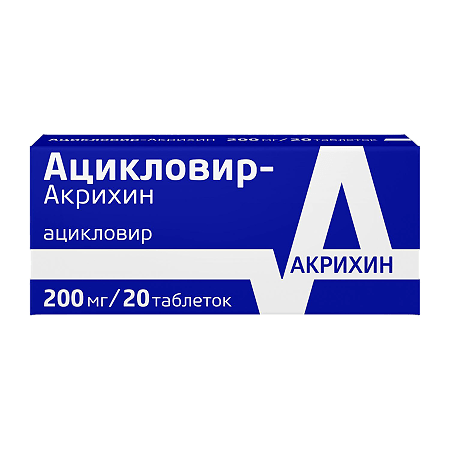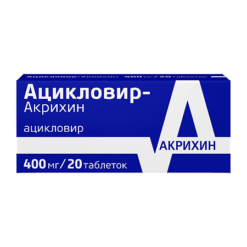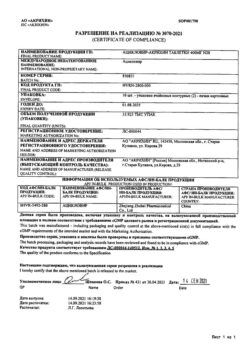No products in the cart.
Description
The antiviral drug is a synthetic analog of thymidine nucleoside.
In infected cells containing viral thymidine kinase, it is phosphorylated and converted into acyclovir monophosphate. Under the influence of guanylate cyclase acyclovir monophosphate is converted into diphosphate and under the influence of several cellular enzymes into triphosphate. High selectivity and low toxicity for humans is caused by the absence of necessary enzyme for formation of acyclovir triphosphate in intact cells of macroorganism.
Aciclovir triphosphate, “being built” into the DNA synthesized by the virus, blocks virus multiplication. Its specificity and very high selectivity of action are also due to its preferential accumulation in cells affected by the herpes virus.
Highly active against Herpes simplex viruses of types 1 and 2; Varicella zoster viruses; Epstein-Barr viruses (types of viruses are listed in ascending order of MAC value of acyclovir).
It is moderately active against CMV.
In herpes it prevents formation of new rash elements, reduces the probability of cutaneous dissemination and visceral complications, accelerates crust formation, reduces pain in the acute phase of herpes zoster. It has an immunostimulatory effect.
Indications
Indications
– Treatment of primary and recurrent severe genital herpes (including in patients with impaired immunity) – orally and parenterally;
– prevention of often recurrent (6 or more cases per year) genital herpes (including in patients with impaired immunity) – orally;
– treatment of primary and recurrent herpes simplex with damage to the skin and mucous membranes, caused by the Herpes simplex virus types 1 and 2, in patients with impaired immunity – orally, parenterally;
– prevention of herpes simplex in patients with impaired immunity (including after transplantation and taking immunosuppressive drugs, HIV-infected patients, during chemotherapy) – orally;
– encephalitis caused by the Herpes simplex virus types 1 and 2 – parenterally;
– treatment of herpes zoster caused by the Varicella zoster virus, in adults – orally; in patients with impaired immunity and with generalized herpes zoster in patients with unimpaired immunity – parenterally;
– prevention of herpes zoster caused by the Varicella zoster virus, after the initial period of using acyclovir for parenteral use in all patients with impaired immunity (including after transplantation and when taking immunosuppressive drugs, HIV-infected patients, during chemotherapy) – orally;
– herpes zoster with eye damage – orally, parenterally;
– generalized infection in newborns caused by the Herpes simplex virus – parenterally;
– chicken pox in patients with unimpaired immunity within 24 hours after the appearance of a typical rash – orally, in patients with impaired immunity – parenterally.
Pharmacological effect
Pharmacological effect
The antiviral drug is a synthetic analogue of thymidine nucleoside.
In infected cells containing viral thymidine kinase, phosphorylation occurs and is converted to acyclovir monophosphate. Under the influence of acyclovir guanylate cyclase, monophosphate is converted into diphosphate and, under the action of several cellular enzymes, into triphosphate. High selectivity of action and low toxicity to humans are due to the absence of the necessary enzyme for the formation of acyclovir triphosphate in intact cells of the macroorganism.
Acyclovir triphosphate, “integrating” into the DNA synthesized by the virus, blocks the reproduction of the virus. The specificity and very high selectivity of the action are also due to its predominant accumulation in cells affected by the herpes virus.
Highly active against Herpes simplex virus types 1 and 2; the virus that causes chickenpox and herpes zoster (Varicella zoster); Epstein-Barr virus (types of viruses are indicated in increasing order of the MIC of acyclovir).
Moderately active against CMV.
In case of herpes, it prevents the formation of new rash elements, reduces the likelihood of skin dissemination and visceral complications, accelerates the formation of crusts, and reduces pain in the acute phase of herpes zoster. Has an immunostimulating effect.
Special instructions
Special instructions
Acyclovir should be prescribed with caution to patients with impaired renal function and elderly patients due to an increase in the half-life of acyclovir. When using the drug, it is necessary to ensure the supply of a sufficient amount of fluid.
Active ingredient
Active ingredient
Acyclovir
Composition
Composition
Active ingredient:
acyclovir 200 mg.
Pregnancy
Pregnancy
Use during pregnancy is only possible if the expected benefit to the mother outweighs the potential risk to the fetus.
If it is necessary to use the drug during lactation, breastfeeding should be stopped.
Contraindications
Contraindications
Hypersensitivity (including to valacyclovir), children under 3 years of age (for solid dosage forms).
With caution. Pregnancy, lactation period.
Side Effects
Side Effects
From the digestive system: in isolated cases – abdominal pain, nausea, vomiting, diarrhea; rarely – transient increase in liver enzyme activity, hyperbilirubinemia.
From the hematopoietic system: rarely – leukopenia, erythropenia.
From the side of the central nervous system: rarely – headache, weakness; in some cases – tremor, dizziness, increased fatigue, drowsiness, hallucinations.
Allergic reactions: skin rash; rarely – allergic dermatitis (when using ointment).
Local reactions: when using the ointment, redness, itching, peeling, burning or tingling are possible.
Other: rarely – alopecia, fever, increased levels of urea and creatinine.
Interaction
Interaction
When used simultaneously with probenecid, the average half-life of acyclovir increases and the clearance of acyclovir decreases.
When taken simultaneously with nephrotoxic drugs, the risk of developing renal dysfunction increases.
Overdose
Overdose
Ingestion of 20 g of acyclovir has been reported. Symptoms: agitation, coma, convulsions, lethargy. Precipitation of acyclovir in the renal tubules is possible if its concentration exceeds the solubility in the renal tubules (2.5 mg/ml).
Overdose with parenteral administration (with bolus administration, or use in high doses, or in patients whose water and electrolyte balance is not properly controlled): increased urea nitrogen, hypercreatininemia, impaired renal function, lethargy, convulsions, coma.
Treatment: maintenance of vital functions, hemodialysis.
Storage conditions
Storage conditions
In a dry place, protected from light, at a temperature not exceeding 25 ° C.
Keep out of the reach of children.
Shelf life
Shelf life
4 years.
Manufacturer
Manufacturer
Akrikhin JSC, Russia
Additional information
| Shelf life | 4 years. |
|---|---|
| Conditions of storage | In a dry, light-protected place at a temperature not exceeding 25 ° C. Keep out of reach of children. |
| Manufacturer | Akrihin HFC JSC, Russia |
| Medication form | pills |
| Brand | Akrihin HFC JSC |
Other forms…
Related products
Buy Aciclovir-Acrihin, tablets 200 mg 20 pcs with delivery to USA, UK, Europe and over 120 other countries.












